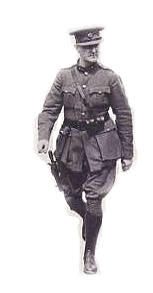Go to famous Irish People |
Famous Irishmen. |
|
|
|
| |
Michael
Collins. |
||||
In July 1921 a truce between the IRA and British forces had been achieved, Collins was a reluctant participant in negotiation with the British in London, which culminated in the signing of the Anglo Irish Treaty on December 6, 1921. Collins, supported by Arthur Griffith, became the most forceful and influential advocate of the treaty within Sinn Fein. In the Daíl debates he argued that although the treaty did not offer the republican state that most in Sinn Fein and the IRA had desired and fought for, it did promise an important measure of freedom which could be developed into the full freedom they desired at a later date. Collins used his personal influence and contacts through the IRA to secure the support of key political and military figures for the treaty within Sinn Fein and the IRA. The treaty was accepted by the Daíl by 64 votes to 57 on January 7, 1922. Collins became chairman of a provisional government responsible for the transition of civil rule from the hands of the British. This was accomplished in the first six months of 1922, as well as the establishment of a police force and army. A general election held in June gave a mandate to the provisional government and the treaty. Acting under British pressure and attempting to assert its authority, the provisional government's troops attacked the anti-treaty IRA in Dublin on June 28. The civil war that ensued lasted until May 1923. On July 12 Collins was appointed commander in chief of the provisional government's forces. During the first two months of the conflict they experienced a number of military successes, forcing the anti-treaty IRA to retreat from all urban areas in Southern Ireland. Collins went on a tour of inspection to his native Cork and was killed in an ambush by extremist republicans near Bandon, on August 22, 1922, at the age of 32. He is buried in Glasnevin cemetery Dublin. A monument to him was erected on the lawn Leinster House. |
||||
|
Go to famous Irish People home page. |
|

 the post office for a time, after which he was employed by a firm
of stockbrokers. It was at this time that he joined the Irish Republican
Brotherhood, (A revolutionary secret society dedicated to establishing
an Irish republic) Early in 1916 he returned to Ireland and took
part in the
the post office for a time, after which he was employed by a firm
of stockbrokers. It was at this time that he joined the Irish Republican
Brotherhood, (A revolutionary secret society dedicated to establishing
an Irish republic) Early in 1916 he returned to Ireland and took
part in the